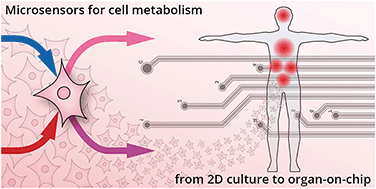Our official English website, www.x-mol.net, welcomes your feedback! (Note: you will need to create a separate account there.)
Microsensor systems for cell metabolism – from 2D culture to organ-on-chip
Lab on a Chip ( IF 6.1 ) Pub Date : 2018-04-05 00:00:00 , DOI: 10.1039/c7lc00942a Jochen Kieninger 1, 2, 3, 4 , Andreas Weltin 1, 2, 3, 4 , Hubert Flamm 1, 2, 3, 4 , Gerald A. Urban 1, 2, 3, 4
Lab on a Chip ( IF 6.1 ) Pub Date : 2018-04-05 00:00:00 , DOI: 10.1039/c7lc00942a Jochen Kieninger 1, 2, 3, 4 , Andreas Weltin 1, 2, 3, 4 , Hubert Flamm 1, 2, 3, 4 , Gerald A. Urban 1, 2, 3, 4
Affiliation

|
Microsensor systems for cell metabolism are essential tools for investigation and standardization in cell culture. Electrochemical and optical read-out schemes dominate, which enable the marker-free, continuous, online recording of transient effects and deliver information beyond microscopy and end-point tests. There has been much progress in microfluidics and microsensors, but the translation of both into standard cell culture procedures is still limited. Within this critical review, we discuss different cell culture formats ranging from standard culture vessels to dedicated microfluidic platforms. Key aspects are the appropriate supply of cells, mass transport of metabolites to the sensors and generation of stimuli. Microfluidics enable the transition from static to dynamic conditions in culture and measurement. We illustrate the parameters oxygen (respiration), pH (acidification), glucose and lactate (energy metabolism) as well as short-lived reactive species (ROS/RNS) from the perspective of microsensor integration in 2D and 3D cell culture. We discuss different sensor principles and types, along with their limitations, microfabrication technologies and materials. The state-of-the-art of microsensor platforms for cell culture is discussed with respect to sensor performance, the number of parameters and timescale of application. That includes the advances from 2D culture to the increasingly important 3D approaches, with specific requirements for organotypic microtissues, spheroids and solid matrix cultures. We conclude on the current progress, potential, benefits and limitations of cell culture monitoring systems from monolayer culture to organ-on-chip systems.
中文翻译:

用于细胞代谢的微传感器系统–从2D培养到芯片上的器官
用于细胞代谢的微传感器系统是细胞培养中研究和标准化的重要工具。电化学和光学读出方案占主导地位,这使得无标记,连续,在线记录瞬态效应成为可能,并提供了显微镜和终点测试以外的信息。在微流体和微传感器方面已经取得了很大进展,但是将两者翻译成标准细胞培养程序仍然受到限制。在这次重要的综述中,我们讨论了从标准培养皿到专用微流体平台的不同细胞培养形式。关键方面是细胞的适当供应,代谢产物向传感器的大量运输以及刺激的产生。微流体技术使培养和测量中的静态条件可以从动态条件转变为动态条件。我们从2D和3D细胞培养中的微传感器集成的角度说明了氧气(呼吸),pH(酸化),葡萄糖和乳酸(能量代谢)以及短期活性物质(ROS / RNS)的参数。我们讨论了不同的传感器原理和类型,以及它们的局限性,微细加工技术和材料。就传感器性能,参数数量和应用时间尺度,讨论了用于细胞培养的微传感器平台的最新技术。这包括从2D培养到日益重要的3D方法的进步,以及对器官型微组织,球体和固体基质培养的特殊要求。我们总结了当前的进展,潜力,
更新日期:2018-04-05
中文翻译:

用于细胞代谢的微传感器系统–从2D培养到芯片上的器官
用于细胞代谢的微传感器系统是细胞培养中研究和标准化的重要工具。电化学和光学读出方案占主导地位,这使得无标记,连续,在线记录瞬态效应成为可能,并提供了显微镜和终点测试以外的信息。在微流体和微传感器方面已经取得了很大进展,但是将两者翻译成标准细胞培养程序仍然受到限制。在这次重要的综述中,我们讨论了从标准培养皿到专用微流体平台的不同细胞培养形式。关键方面是细胞的适当供应,代谢产物向传感器的大量运输以及刺激的产生。微流体技术使培养和测量中的静态条件可以从动态条件转变为动态条件。我们从2D和3D细胞培养中的微传感器集成的角度说明了氧气(呼吸),pH(酸化),葡萄糖和乳酸(能量代谢)以及短期活性物质(ROS / RNS)的参数。我们讨论了不同的传感器原理和类型,以及它们的局限性,微细加工技术和材料。就传感器性能,参数数量和应用时间尺度,讨论了用于细胞培养的微传感器平台的最新技术。这包括从2D培养到日益重要的3D方法的进步,以及对器官型微组织,球体和固体基质培养的特殊要求。我们总结了当前的进展,潜力,



























 京公网安备 11010802027423号
京公网安备 11010802027423号